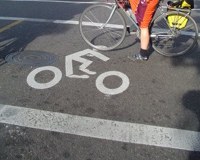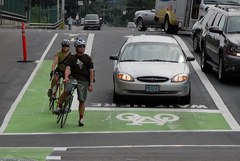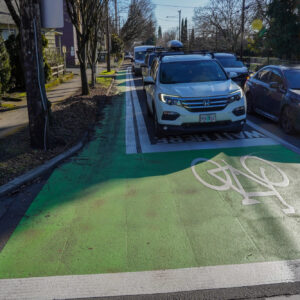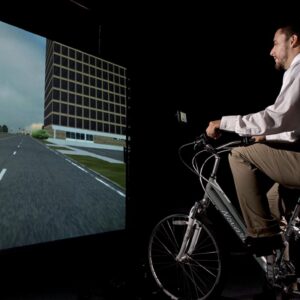
The old-school bike box at SE 39th and Clinton.
|

The colored version at SE Hawthorne and 7th.
|
The Federal Highway Administration (FHWA) has officially approved the City of Portland Office of Transportation’s (PDOT) “Request to Experiment” with green colored bike boxes on one condition; they must test their effectiveness without the green coloring many people credit with their success.
PDOT filed their Request to Experiment with the FHWA back in January. Such a request is not mandatory, but it is a required part of the process to get colored bike boxes added to the all-important Manual on Uniform Traffic Control Devices (MUTCD) — a set of guidelines used by traffic engineers across the country.
According to a statement prepared by PDOT’s head traffic engineer Rob Burchfield, Portland will comply with the FHWA’s decision. This means that three of the remaining locations pegged for bike boxes will be installed with striping and signage only, without the green color used in eight bike box intersections installed since March.
The non-colored treatments will then be evaluated “for a period of time while data is collected.” Once that data is collected, the green color will be added and another round of data will be evaluated: “This methodology is intended to help better discern the relative effectiveness of coloring the boxes as part of the overall treatment.”

From anecdotal evidence, my own observations, and from reports by the Police Bureau, it seems Portland’s bike boxes are enjoying a high rate of compliance by road users. Some folks think a major reason for that compliance is the highly visible green color. But that’s not necessarily an accurate assumption according to Richard Moeur, Chair of the MUTCD’s Bicycle Technical Committee — a volunteer group that advises the FHWA.
Moeur says he’s concerned that PDOT is testing too many new things at once (a new color, new signage, new symbols, etc…). “What you end up with,” he told me today is, “that it’s impossible to determine which device is having an effect on the traveling public.”
The problem, Moeur says, is that PDOT has “made the assumption that you need this entire package to have an effective bike box.”
“The problem is that the City of Portland has made the assumption that the color is very effective.”
— Richard Moeur, Chair of the MUTCD Bicycle Technical Committee
Moeur feels that it’s important to determine how effective each individual component is before moving forward with an official adoption. He’s also concerned that colored lanes and boxes are expensive and that not enough research has been done on how/if it significantly impacts behavior.
“Color is expensive… and there are a lot of assumptions that it will change user behavior. When it doesn’t, but you think it does, that is the big concern… I think we need more information.”
This “phased implementation approach” will begin on October 1st at the intersections of SW Terwilliger and Taylors Ferry, NW Broadway and Hoyt, and at SE 39th and Clinton (where an old bike box already exists).
Next week (8/06), PDOT will be back in front of City Council for an update on their bike box program (known officially as the Bicycle Safety: Bike Boxes and Alternatives Report to Council).
Since launching their bike box campaign in October of 2007 (in the wake of two fatal crashes that involved right-turning motor vehicles), PDOT has painted eight intersections with bike boxes. Of the 14 original intersections identified, one is delayed and three have been removed from consideration for the treatment for various reasons*.
See all of BikePortland.org’s bike box coverage here.
*At the request of a commenter below, here are the three intersections that are no longer being considered for the bike box treatment (as per PDOT):
- N Interstate at Greeley (after further analysis and public involvement closure of the right turn is recommended)
- NE Broadway at Williams (after further analysis the geometry of this intersection precludes effective use of the bike box at this location)
- NW Lovejoy at 9th Ave (delayed due pending design and construction of the streetcar extension project)







Thanks for reading.
BikePortland has served this community with independent community journalism since 2005. We rely on subscriptions from readers like you to survive. Your financial support is vital in keeping this valuable resource alive and well.
Please subscribe today to strengthen and expand our work.
Which 3 were removed? Why were they removed?
This seems a little dangerous to me. We know a system is working, and working very well. Now we\’re going to take away safety features to see how little we can get away with before it\’s rendered ineffective? How many people will have to get ran over before we realize that all devices in the \”package\” work to reduce accidents? If the color is taken away and 10 more people are hit, is it worth the savings? If the signage is taken away and it adds 2 more people being hit, is that worth the savings?
Color is expensive? Please.
How many times have I had to listen to the argument if a mandatory helmet law for adults, hand brake on a fixed-gear bike, child safety seat for an 8 y.o., etc. etc. saves *just one life* it is worth it?
Clearly the difference is whose money is being spent.
I\’ve been riding the SE Clinton / 39th intersection twice a day for many years now, and drivers don\’t notice the bike boxes there or stay behind them (unless a biker happens to already be in the box when they pull up.) I don\’t know what it takes to get a traffic device \”proven\” to work or not work, but I feel secure in saying that the non-color bike boxes don\’t accomplish their intended goal.
Many drivers at 39th and Clinton don\’t even notice the \”No Right Turn on Red\” sign, much less the bike boxes. Heck, some driving on 39th don\’t even notice the stoplight and run the red light when cyclists are crossing the intersection.
Translation: to be considered for national adoption, it must be as cheap as possible.
With logic like that, automobiles would never have air bags, anti lock brakes etc.
Of critical concern to PDOT is whether adoption of the bike box idea without color by the MUTCD, would preclude PDX from using color from that point on.
There\’s a bike box two blocks from my house (in SF, on 14th & Folsom) and I didn\’t even realize what it was for a whole month, despite the fact that I\’m often in it (since I\’m usually turning left there, I\’m out of the bike lane). I don\’t think I\’ve ever once seen a car stop for it.
Maybe once bike boxes are common enough that people get used to seeing them you won\’t need the color. But while they\’re still a relatively new phenomenon, it makes sense to help point them out.
I think it\’s a valid question from the FHWA — why include a feature in a traffic control device that\’s not proven to be part of the overall solution? If the green color is pointless, doing a real test would point that out pretty effectively. I don\’t think it\’s out of pure cheapness — after all, airbags, ABS brakes, etc. are pretty useful safety features.
That said, I think the green color will be proven a critical part of bike box effectiveness. It\’s totally changed the interactions at my local bike box intersection from scary to friendly.
I do wonder what their test criteria are — do they post a spotter/counter at the site and tally up positive vs. negative interactions, or what?
jonno: I\’d imagine you could just count the number of people who stop before the bike box vs. the number that stop on top of it. Should be fairly easy. If you really wanted to be scientific about it, you could count for a week, then paint the exact same bike box and do a recount. I imagine the green will make a significant difference, but yeah, I don\’t see the harm in testing it.
Well, crosswalks aren\’t new but people still seem to stop in the middle of them. Color is the next best thing to a physical barrier. Pop-up bollards on red lights anyone?
I\’m with Meghan and Stacy (#4). Been riding it several times a week, twice daily in summer, since it was installed. The uncolored Clinton box works poorly.
I\’ve had my back wheel clipped by a right-on-red (RoR) turner, been honked at by folks wanting to RoR while on my bike and in my car.
Please FHWA, keep the colored paint!
oh…and please PPB, do an enforcement sting there!!!
Color is expensive.
So is testing something that is completely obvious.
So is making things that don\’t work.
Let\’s back up and test to see if the cars stop better with round wheels or square wheels.
How about we test to see if people know what they are talking about before the get to make decisions with tax money.
I am going to test to see if my glasses work better on my face or in a drawer.
\”Pop-up bollards on red lights anyone?\” -Paul
I\’ve been a fan of this idea for a long time. I\’d also like to see them implemented at stop signs. You pull up the bollard and after a second the bollard lowers and allows you to move forward. I do not know who many times I\’ve been nearly hit by vehicles (bikes and cars) as a pedestrian when they stop halfway into the crosswalk rather than behind the stop bar/stop sign.
\”How about we test to see if people know what they are talking about before the get to make decisions with tax money.\” -Mike
I\’ve also been a big fan about this for awhile. Voters should have to pass a test every year their going to vote. I\’m not sure how the test should be setup (i.e. standardized, purely about the issues, purely about level of comprehension, etc.), but we need to end the \”I\’m voting for him, because he\’s more the type of guy you could sit down and have a beer with.\” Taxes to – \”I\’m tired of paying taxes, but I want the government to provide me with more!\”
It\’s not the color itself that\’s expensive. (well, maybe it is) It\’s the increase in the amount of paint used and time spent painting vs a couple of stripes and a stencil. Basically you have to send a crew out twice. Once to lay down color, then again to paint the striping over it.
I don\’t think it\’s an unreasonable concern given the poor results we seemed to have with the old blue bikelanes. People seemed to miss those all the time.
However, I think the green is a much more visible color than the blue was, and makes a bigger impact than stripes alone.
Dear Mr. Moeur,
You say that you are concerned that, \”this is testing too many new things at once (a new color, new signage, new symbols, etc…)\”. Well let me explain something, driving a car is a privilege, not a right! That is why you have to take a test and pay for the right to drive. So here\’s an idea….EDUCATE MOTORISTS. Instead of giving a renewal of a drivers license to everyone without retesting, how about we test people every so often. New rules to the road, new road signs, etc. are appearing more rapidly these days. Heck, I\’d say 40% of people I know don\’t even know how to use a roundabout! Giving out a renewal on a drivers license every 8 years and not re-testing is a dangerous way to tell motorists to do what ever they want on the road, because we don\’t care if you know the laws or not.
I say re-test drivers, make them learn the rules of the road they drive on! We do not educate drivers and then throw all these new ideaa at them and they have no idea what to do! Wake up and smell the Starbucks Mr. Moeur.
Thanks,
Someone who keeps up on the laws of the road and actually follows them.
We have uncolored boxes in NYC, they don\’t work at all.
No no no no no !!
Wow, let\’s hope that the eight that are installed without green coloring fail miserably, so that we can submit the data, with control data from our green boxes, to show that green is more effective!
PS – annecdotally, the current bike box at Se 39th and Clinton, that is unpainted, has about two percent compliance from motorists I would estimate. Nobody stops behind it, and everybody turns right on red.
I would heartily invite Richard Moeur to come out to Portland and spend an hour or so during rush hour, observing the compliance rates at this intersection location.
Russell-
Standardized tests for voters? How about a poll tax? Perhaps only let white, male property owners vote.
I think you just failed your own test. It is YOU who should not be allowed to vote!
This is fairly ridiculous. It is a perfect example of bureaucracy ignoring common sense. The world is FULL of examples that show bright colors get the attention of living organisms. But we better spend a bunch of time and money JUST TO BE SURE.
Maybe we should also try replacing an entire bike box with a small 8.5\” x 11\” sign off to the side — that would certainly be cheaper, and who knows, it might be just as effective.
Sigh.
So… human guinea pigs ? Squished human guinea pigs ? For the \”black and white\” boxes to fail requires injured bicyclists, doesn\’t it ? Isn\’t there a law against human test subjects, at least without their consent ? What is more expensive, the paint or the cost of a human life ?
Elisabeth, why do you hope bike boxes without green paint fail? What if we find out it works just as well without that paint? Have you considered the VOC\’s produced by extra paint?
Richard Moeur, who is a cyclist (try a google search to reach his home page), is suggesting the City of Portland be more systematic in its testing. The validity of bike boxes and their expansion to other locations and other communities will be enhanced by documentation and by having tests peer reviewed by respected professionals.
@jrep
As has already been mentioned, we have a bike box without paint, and it has been very often observed to be completely ignored.
People have enough to try and look for while driving, why make the bike box something else they have to really work to see?
There is systematic, and there is ignoring common sense.
I can vouch the paint works. Id say sometimes up to 50% of cars are completely ignorant of how to act at SE Clinton and 39th. Unless they all just feel the need to not abide by the rules. Which is a possibility too I suppose.
I dont think its a bad test, but the color is pretty obviously effective. Maybe striping it at 45 degrees in green would be slightly cheaper. Or maybe on green bar before the box would let people to know to stop before and not on it. There are a million design options. But filling it green is working.
People don\’t stop for unpainted cross walks, so why would they stop for unpainted bike boxes. There are a few painted cross walks and if you stop to watch you would be amazed at how many people actually stop behind the line for them. I know someone said something about the blue bike lanes not working, but I find them working better than none paited lanes at intersections that people turn at. Cars crowd the lane a whole lot less.
For all the people kvetching about the FHWA, what they are doing is applying science to this. They are trying to determine, via statistical proof, whether or not the green adds to the efficacy of the boxes.
And it is prudent and responsible of them to look for not the \”cheapest\” way of doing something but rather to make sure that it\’s no more expensive than it has to be.
In the end, I\’d venture to guess that it will be the green that proves the most effective component of the boxes\’ success and the FHWA will make it either a recommended or required standard in creating bike boxes.
The \”bike box\” at 39th and Clinton is not very similar to the other locations, and it\’s not just the absence of the green paint. The point is let\’s find out why the bike boxes are working, if they are. Maybe it\’s the green paint, maybe it\’s the No Turn on Red signs, maybe it\’s the Wait Here on the pavement, maybe it\’s the enforcement.
Are you so absolutely confident based on a few personal observations that the green paint is the critcal element that makes bike boxes work?
Does your new bike ride better than your old one because 1)it has more gears 2)it\’s a road bike instead of a mountain bike 3)it has high pressure tires or 4) it\’s a different color? Too many variables makes it hard to judge what\’s critical.
What\’s wrong with a well-defined, systematic approach based on scientific principles?
#25
Science is great. I am a big believer in it — but let\’s not forget we\’re talking about a measure intended to save lives.
In the endeavor to add additional digits to the right of the decimal point, people very well may be hurt.
@jrep
I guess my issue is that the new bike boxes have been observed, already, to be highly visible and effective.
If you really want to be scientific and systematic, then propose at least 3-5 different configurations, create some control groups, and go through the full process. I suspect you are not advocating that level of rigor?
So I have an issue with saying \”let\’s loose the green paint and see what happens\” and calling that scientific, especially in light of the fact that we have a relatively inexpensive solution that is already observed to be effective.
So racist.
jrep: I think if the issue is visibility then a bright green bike would be better than a flat black bike! Same with the bike box.
Can we experiment with making car horns and police sirens really quiet.
Oy vey. The FHWA is doing us a favor. In the end, they are (probably) making clear without a doubt that the green is a critical component of the bike boxes\’ success.
This is a pilot program. This is not an established thing. Portland already had to get an allowance just to do it. We are setting the precedent for the standard of the rest of the national system.
We have some uncoloured bike boxes in Cambridge UK – useless. In fact, worse than useless, as the cars pull into them and are then further forward than if they weren\’t there at all.
Let them collect their data but do it fast.
Here\’s one data point for the analysts. I\’ve biked on and driven on routes with the boxes and it\’s unambiguous where I am to stop as a motorist. So often there are a bunch of lines such that it\’s essentially a jumble. For turning on red the jumble of lines is meaningless to me and I take queues from the intersection geometry and put myself in the subjective correct place. The lines might help but it\’s not super clear. I always look for bikes before any lateral move.
With a bike box, I know where to stop *and* I\’m confident that drivers behind me won\’t apply pressure or honk because they think I\’m not far enough forward. Having this clarity makes everything safer and much less stressful.
When riding, I usually sit where the bike lane is and not in the box as I\’m alone in the box. But being ahead lets me get through before anyone can make any mistakes that impact (get it) me.
Did anyone visit Richard Moeur\’s website? He\’s a Vehicular Cycling jihadist with a lot of influence on our national transportation infrastructure policies. After reading his paper, I no longer wonder why so much bicycle infrastructure sucks in this country – he and others keep it that way!
Sorry, but anything that man suggests is going to be suspect in my book
This request isn\’t smart at all. Why not test with and without signage? I would assert that most drivers don\’t pay attention to signs and that there\’s an overabundance of conflicting and confusing written signage on our road network, which is part of the reason automobile drivers don\’t yield to pedestrians in so many places, in addition to other regularly-occurring driver deficiencies. This request is so old school in its intent, it\’s pathetic. The color is the one component of this package that is beyond assertion.
one oie.
if bike were bananas, would you eat a pie that was 100% bananas?
No
You need cream (pavement)
sugar (stoplights)
etc (everything else)
there is not 100% funding for safety. We need to spend our $ wisely. Or would you like to forgo bikelanes altogether?
If we want more, we have to fundamentally shift how the pie is sliced, IMHO
I don\’t mean to be rude but what is the point of the boxes? What is wrong with waiting in the bike lane for the light to change. Seems like bad drivers will run in to cyclists no matter what striping there is and good drivers will yield the appropriate amount of space to a bike that has the Right-Of-Way. Could someone please explain and enlighten me on this. I could so without personal attacks as this is an honest inquiry.
Ian, the point of the bike boxes is to lower the rate of one of the most common causes of deaths and injuries to bicyclists, the right hook. I understand that there is some empirical evidence demonstrating their effectiveness at this. If you search through the archives on Jonathan\’s coverage of this, you will likely find much more detail.